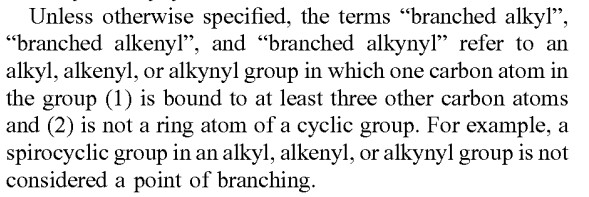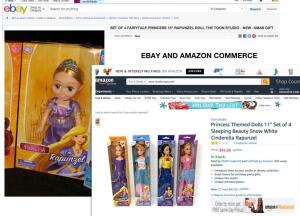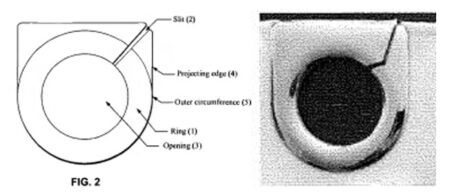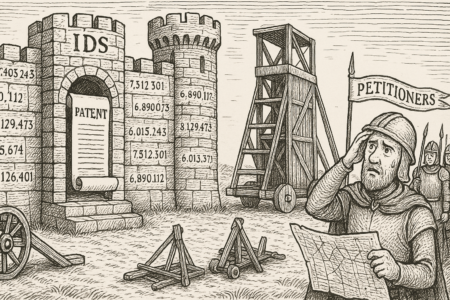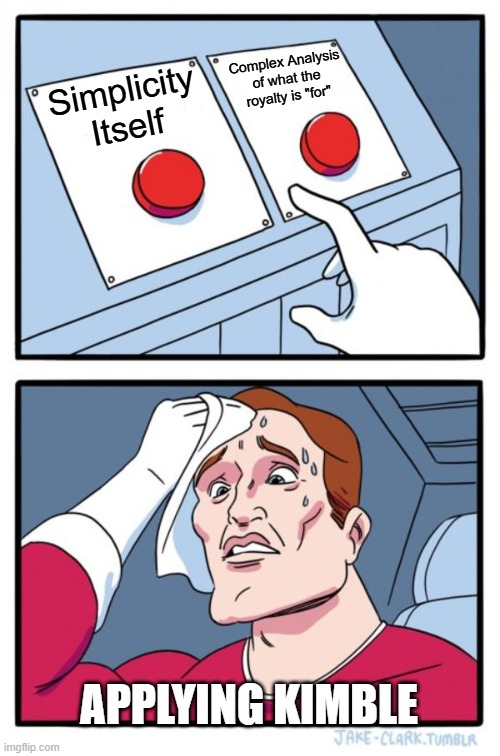All posts by Dennis Crouch
Discovering the Crown Jewels: Irreversible Harm in the Digital Age
Maintaining a Speedy and Robust IPR Process Should Be a Major Focus of John Squires’ Patent Quality Efforts
Guest Post by Shawn Miller, Professor of Practice, University of San Diego School of Law; CodeX Fellow, Stanford Law School; Creator, Stanford NPE Litigation Database
Just a week ago, I began dusting off the half-written paper drafts of two empirical research projects that have mostly sat on my shelf the past year while teaching an overload to aid my colleagues on sabbatical. Brushing up on current events at the USPTO, it is clear that neither patent policy stakeholders nor the second Trump administration waited around for this law professor’s summer break. We have seen several months of the very active Acting USPTO Director Coke Morgan Stewart’s reshaping of the Patent Trial and Appeal Board’s (“PTAB’s”) process of reviewing Inter Partes Review (“IPR”) petitions, particularly in ways that tend to favor patent owners. Additionally, within the past two weeks we have had the Judiciary Committee Hearing of John Squires, the President’s nominee to serve as his permanent USPTO Director.
It seems likely that Squires will be confirmed soon and begin to act on the priorities he outlined at his hearing, two of which just so happen to overlap the topics of the two projects I am scrambling to complete this summer: patent quality and IPR reform. With my slow writing pace and the clear indications that the “reform” the administration has in mind would actually tend to harm patent quality when and where it matters, I asked—and Professor Crouch graciously agreed—to publish this guest post.
To start, what is patent quality? Put simply, it is the likelihood that a granted patent meets all of the statutory requirements for protection. In other words, low quality patents are likely invalid. Different stakeholders naturally emphasize different aspects of patent quality; for instance patent owners might prioritize breadth sufficient to cover potential infringing products or claim sets robust enough to survive validity challenges. In my own research, I have focused on novelty and non-obviousness because granted patents lacking these traits are usually devoid of innovation, and promoting new technology is the primary objective for granting inventors exclusive rights in the first place. I qualify patent quality with “likelihood” because it makes sense to think of inventors’ rights as probabilistic and contingent on unknown or misunderstood information (e.g., prior art) that supports or casts doubt on the validity of the claimed matter down the road when a granted patent is tested during enforcement. (more…)
Federal Circuit Dismisses Patent Owner’s Appeal of Favorable IPR Decision for Lack of Standing
Strict Standard for Overriding Patent Lexicography in COVID Vaccine Patent Battle
USDOJ: Contributory Infringement Requires Conscious and Culpable Acts
Federal Circuit Takes Center Stage in Trump’s Tariff Campaign
On the Edge of Claim Construction: Federal Circuit Splits Over What Counts as a Tile’s ‘Edge’
Uninvited Guests: The Federal Circuit’s Problematic Revival of Waived Arguments
Injury vs. Discovery: The Goldilocks Problem and Copyright’s Statute of Limitations
by Dennis Crouch & Tim Knight
The Supreme Court will hold its conference on May 29, 2025, to decide whether to grant certiorari in RADesign, Inc. v. Michael Grecco Productions, Inc. (No. 24-768), a case that could fundamentally reshape how copyright’s three-year statute of limitations operates. The petition, which has attracted significant attention from copyright scholars and practitioners, presents a deceptively simple question with profound implications: whether a copyright infringement claim “accrues” when the infringement occurs (the “injury rule”) or when the copyright holder discovers or reasonably should have discovered the infringement (the “discovery rule”). Although the circuit courts all appear to agree that some form of a discovery rule should persist, we believe the deeper question is the rule’s form. We believe in this case that the district court offered the better approach by permitting the discovery rule, but only after taking a contextual approach requiring reasonable diligence that considers the copyright holder’s circumstances while maintaining meaningful protections against fraudulent concealment.
- Dennis Crouch, Bane and Antidote: Copyright Statute of Limitations, PATENTLY-O (Feb. 23, 2025).
- Dennis Crouch & Tim Knight, Discovery, Injury, and Diligence: Reconciling Subjective and Objective Copyright Limitations Standards Post-Warner Chappell, PATENTLY-O (Jan. 2, 2025).
- Dennis Crouch & Timothy Knight, Pour Me Another: The Supreme Court Revisits the ‘Bad Wine’ of the Copyright Discovery Rule, PATENTLY-O (Feb. 21, 2024).
- Dennis Crouch, Discovering the Limit: Calculating the Copyright Damages Timeline, PATENTLY-O (Sept. 14, 2023).
Michael Grecco, a professional photographer, took photographs of model Amber Rose in 2017, wearing shoes designed by Ruthie Davis. Grecco alleges that Davis’s company, RADesign, reposted some of these photos on its website and social media platforms without authorization. Although the photos were posted in 2017. Grecco claims he did not discover this infringement until February 2021 and filed suit in October 2021, four years after the alleged infringement began but less than one year after his claimed discovery.
The copyright statute of limitations, § 507(b), requires any lawsuit be filed “within three years after the claim accrued,” and RADesign moved to dismiss the case as time-barred since it was filed four years after the infringing acts. The district court agreed, although it did consider whether to extend the statute of limitations based upon the copyright holder’s delay in discovering the infringement. Applying a “reasonable diligence” standard, the court concluded that someone in Grecco’s position—specifically, a sophisticated copyright holder with extensive enforcement experience—should have discovered the infringement within the three-year limitations period. This sophistication includes the filing of 100+ copyright infringement actions. Grecco’s own complaint touted his extensive history of actively policing infringements and litigation, making late discovery implausible under those specific circumstances.
On appeal, however, the Second Circuit reversed. The appellate court held that the discovery rule uniformly determines when copyright claims accrue, irrespective of a plaintiff’s sophistication or enforcement history. According to the panel, there is no special diligence standard for sophisticated plaintiffs; instead, the discovery rule must be applied objectively, uniformly, and without presumptions. Since the complaint itself did not conclusively show that Grecco should have discovered the infringement earlier, the Second Circuit reinstated the suit. One takeaway from the Second Circuit decision is that it creates the anomalous result where undercapitalized first-time participants with no legal experience or monitoring capabilities are asked to conduct the same level of monitoring as the largest, most sophisticated copyright holder with vast monitoring resources. We think this is wrong. To be clear, we are not necessarily arguing for two different standards, but rather an approach that places the reasonableness within the factual context – what would have been reasonable for the copyright holder to do in the given situation.
Further, the objective standard adopted by the Second Circuit is not in the spirit of the discovery rule. The core of the discovery rule is based on a known or should have known standard. While there may be a debate on the requisite level of monitoring diligence by the copyright holder, the Second Circuit essentially eliminates this standard. Rather, the appellate court’s opinion more effectively reduces the discovery rule to merely a knowledge standard.
RADesign’s pending Supreme Court petition challenges the Second Circuit’s interpretation and presents the following question: Does a copyright infringement claim accrue when the infringement occurs (injury rule) or when the infringement is discovered or reasonably should have been discovered (discovery rule)? The petition is set for conference on May 29, 2025, with extensive briefing and amici participation already completed. This includes an excellent amicus brief from Prof. Tyler Ochoa. Although the circuit courts appear to be continuing to maintain a discovery rule in copyright cases, Justice Gorsuch’s 2024 dissent in Warner Chappell Music v. Nealy argued strongly against the discovery rule as inconsistent with the statutory text and traditional limitations principles. (more…)
Inherent Disclosure and Implicit Construction
Perlmutter v. Trump: Does the President Control the Copyright Office?
Rapunzel, Rapunzel, Let Down Your Generic Hair (and Let Us In)!
The Remedies Remedy is Almost Complete: EcoFactor v. Google
by Dennis Crouch
The Federal Circuit’s en banc decision in EcoFactor v. Google marks a significant tightening of standards for admitting patent damages expert testimony. The court (in an 8–2 split) overturned a $20 million jury award by excluding the patentee’s expert evidence as insufficiently reliable under Federal Rule of Evidence 702 and Daubert. Writing for the majority, Chief Judge Moore treated what traditionally might have been viewed as a factual dispute over “comparable” license agreements as, instead, a matter of contract interpretation for the court. In doing so, the majority held that the trial judge failed in his gatekeeping duty by allowing the jury to hear an expert opinion founded on speculative leaps—namely, the assumption that prior licensees agreed to a particular royalty rate that was not reflected in the actual license terms. Two dissenting judges (Judges Reyna and Stark) each criticized the court for overstepping the proper scope of Rule 702 and for usurping the jury’s role in weighing evidence. As I discuss below, I believe that the dissents have the better view of this case. [Read the Decision]
I see this case as part of a crafted doctrinal transformation that I call the “Remedies Remedy,” that began with the Supreme Court’s undermining of injunctive relief in eBay Inc. v. MercExchange, L.L.C., 547 U.S. 388 (2006) and was then followed by a series of Federal Circuit decisions tightening the requirements for proving monetary damages. For example, the court abolished the old 25% rule of thumb for royalties as arbitrary and unreliable (Uniloc USA, Inc. v. Microsoft Corp., 632 F.3d 1292 (Fed. Cir. 2011)), reinforced the requirement to apportion damages to the patented feature’s value (LaserDynamics, Inc. v. Quanta Computer, Inc., 694 F.3d 51 (Fed. Cir. 2012)), and demanded closer scrutiny of “comparable” license agreements used as benchmarks (Lucent Techs., Inc. v. Gateway, Inc., 580 F.3d 1301 (Fed. Cir. 2009); ResQNet.com, Inc. v. Lansa, Inc., 594 F.3d 860 (Fed. Cir. 2010)). The thrust of these cases is a clear message: patent damages must be grounded in sound economic reasoning and actual evidence, not rules of thumb or tenuous analogies. And, without sufficient expert testimony, juries will not be permitted to hear the evidence. (more…)

